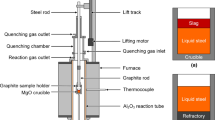Abstract
The origin, formation mechanism, and evolution of SiO2-type inclusions in Si-Mn-killed steel wires were studied by pilot trials with systematical samplings at the refining ladle, casting tundish, as-cast bloom, reheated bloom, and hot-rolled rods. It was found that the inclusions in tundish were well controlled in the low melting point region. By contrast, MnO-SiO2-Al2O3 inclusions in the as-cast bloom were with compositions located in the primary region of SiO2, and most CaO-SiO2-Al2O3-MnO inclusions lied in primary phase region of anorthite. Therefore, precipitation of SiO2 particles in MnO-SiO2-Al2O3 inclusions can be easier than in CaO-SiO2-Al2O3-MnO inclusions to form dual-phase inclusions in the as-cast bloom. Thermodynamic calculation by the software FactSage 6.4 (CRCT-ThermFact Inc., Montréal, Canada) showed that mass transfer between liquid steel and inclusions resulted in the rise of SiO2 content in inclusions from tundish to as-cast bloom and accelerated the precipitation of pure SiO2 phase in the formed MnO-SiO2-Al2O3 inclusions. As a result, the inclusions characterized by dual-phase structure of pure SiO2 in MnO-SiO2-Al2O3 matrix were observed in both as-cast and reheated blooms. Moreover, the ratio of such dual-phase SiO2-type inclusions witnessed an obvious increase from 0 to 25.4 pct before and after casting, whereas it changed little during the reheating and rolling. Therefore, it can be reasonably concluded that they were mainly formed during casting. Comparing the evolution of the inclusions composition and morphology in as-cast bloom and rolled products, a formation mechanism of the SiO2-type inclusions in wire rods was proposed, which included (1) precipitation of SiO2 in the formed MnO-SiO2-Al2O3 inclusion during casting and (2) solid-phase separation of the undeformed SiO2 precipitation from its softer MnO-SiO2-Al2O3 matrix during multipass rolling.












Similar content being viewed by others
References
S. Maede, T. Soejima, T. Saito, H. Matsumoto, H. Fujimoto, and T. Mimura: 72 nd Steelmaking Conference Proceedings, Chicago, IL, 1989, pp. 379–85.
G.M. Fauling: Ironmak. Steelmak., 1999, vol. 26, pp. 29–36.
Y.B. Kang, and H.G. Lee: ISIJ Int., 2004, vol. 44, pp. 1006-15.
K. Karihara: Kobelco Tech. Rev., 2011, vol. 30, pp. 62-65.
J.D. Seo, Y.T. Kim, and D.H. Kim: 5 th International Congress on the Science and Technology of Steelmaking, Dresden, 2012, pp. 1250–54.
S.H. Chen, M. Jiang, X.F. He, and X.H. Wang: Int. J. Miner. Metall. Mater., 2012, vol. 19, pp. 490-8.
J.S. Park, and J.H. Park: Metall. Mater. Trans. B, 2014, vol. 45, pp. 953-60.
R. Kiessling: Non-Metallic Inclusions in Steel, Part I Inclusions Belonging to the Pseudo-Ternary MnO-SiO 2 -Al 2 O 3 and Related System, The Metals Society, London, U.K., 1968, pp. 17-25.
J. Kawahara, K. Watanabe, T. Banno, and M. Yoshida: Wire J. Int., 1992, vol. 25, pp. 55-61.
T. Sugimura, S. Kimura, K. Sakamoto, A. Yoshida, and T. Inoue: Patent China CN 101443468 B Kobe Steel, Ltd., 2012.
S. Feichtinger, S.K. Michelic, Y.B. Kang, and C. Bernhard: J. Am. Ceram. Soc., 2014, vol. 97, pp. 316-25.
H. Shibata, K. Kimura, T. Kimura, T. Tanaka, and S. Kitamura: ISIJ Int., 2011, vol. 51, pp. 1944-50.
H. Shibata, T. Tanaka, S. Kitamura, and T. Kimura: Ironmaking Steelmaking, 2010, vol. 37, pp. 522-8.
W. Choi, H. Matsuura, and F. Tsukihashi: ISIJ Int., 2011, vol. 51, pp. 1951-6.
K.H. Kim, S.J. Kim, H. Shibata, and S. Kitamura: ISIJ Int., 2014, vol. 54, pp. 2144-53.
X.H. Wang, X.G. Li, F.X. Huang, H.B. Li, and J. Yang: Steel Res. Int., 2014, vol. 85, pp. 155-63.
Acknowledgments
Sincere gratitude and appreciation is expressed by the authors to Xingtai Iron & Steel Corp., Ltd. for supporting of the research and great help during industrial sampling.
Author information
Authors and Affiliations
Corresponding author
Additional information
Manuscript submitted May 25, 2015.
Rights and permissions
About this article
Cite this article
Wang, K., Jiang, M., Wang, X. et al. Formation Mechanism of SiO2-Type Inclusions in Si-Mn-Killed Steel Wires Containing Limited Aluminum Content. Metall Mater Trans B 46, 2198–2207 (2015). https://doi.org/10.1007/s11663-015-0411-1
Published:
Issue Date:
DOI: https://doi.org/10.1007/s11663-015-0411-1




